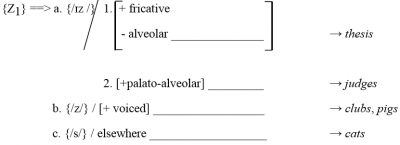allomorph
Different morphs representing the same morpheme are called the 'allomorphs of the morpheme; they are different realizations of a morpheme.
Example 1: The realizations of the English plural {Z1} A well-described example is the realization of the plural in English {Z1} which is either realized as a voiced or voiceless allophone depending on the quality of the previous phoneme. The morpho-phonemic rule representing the distribution of the plural s realizations looks like this:

Example 2: The prefixes in the following words can be argued to be all representations, i.e. allomorphs, of the same morpheme IN-.
- inadequate
- illogical
- impossible
- irreplacable
All of the prefixes in these examples share the same meaning and function. Their selection is determined by context, i.e. by their phonetic environment. The terminating phoneme of the prefix is assimilated to the phonetic (sound) properties of the initial phoneme of the word to which the prefix becomes attached.
The rule in the above case works as follows:
- im- is selected when the word to which the prefix becomes attached starts with a bilabial sound
- il- is selected when the word to which the prefix becomes attached starts with the phoneme l
- ir- is selected when the word to which the prefix becomes attached starts with the phoneme r
- in- is selected in any other phonetic environment, i.e. before any other consonant or before vowels
This process of context determined selection is called phonological conditioning.